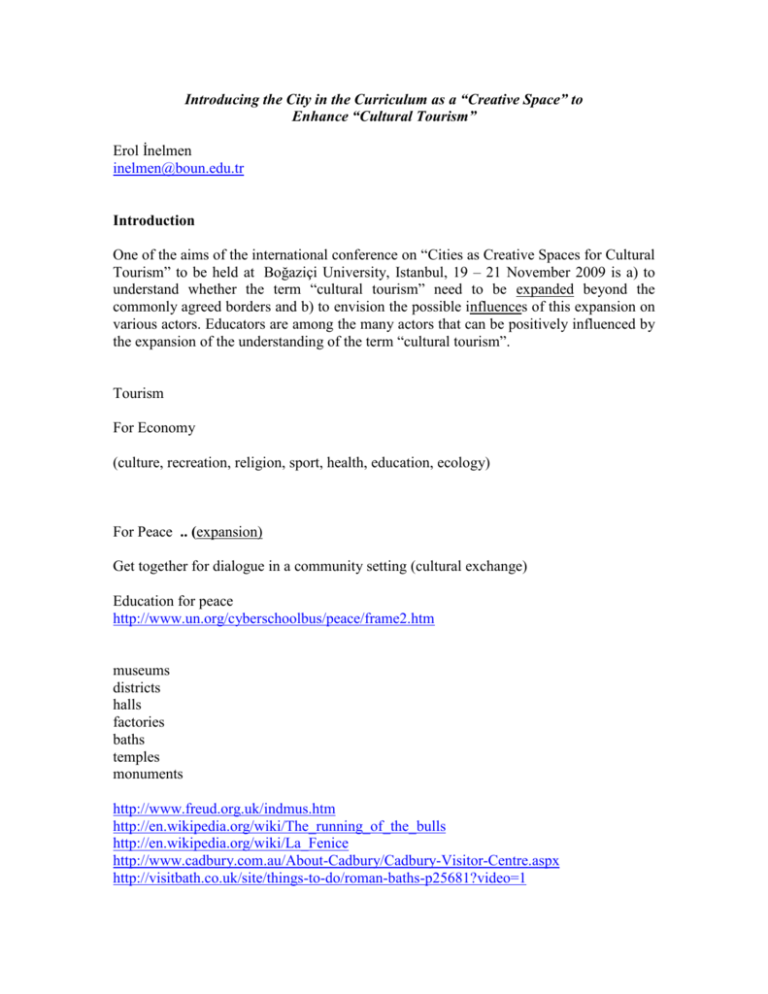creative_cities09
advertisement

Introducing the City in the Curriculum as a “Creative Space” to Enhance “Cultural Tourism” Erol İnelmen inelmen@boun.edu.tr Introduction One of the aims of the international conference on “Cities as Creative Spaces for Cultural Tourism” to be held at Boğaziçi University, Istanbul, 19 – 21 November 2009 is a) to understand whether the term “cultural tourism” need to be expanded beyond the commonly agreed borders and b) to envision the possible influences of this expansion on various actors. Educators are among the many actors that can be positively influenced by the expansion of the understanding of the term “cultural tourism”. Tourism For Economy (culture, recreation, religion, sport, health, education, ecology) For Peace .. (expansion) Get together for dialogue in a community setting (cultural exchange) Education for peace http://www.un.org/cyberschoolbus/peace/frame2.htm museums districts halls factories baths temples monuments http://www.freud.org.uk/indmus.htm http://en.wikipedia.org/wiki/The_running_of_the_bulls http://en.wikipedia.org/wiki/La_Fenice http://www.cadbury.com.au/About-Cadbury/Cadbury-Visitor-Centre.aspx http://visitbath.co.uk/site/things-to-do/roman-baths-p25681?video=1 http://en.wikipedia.org/wiki/Sagrada_Familia http://en.wikipedia.org/wiki/Valle_de_los_Ca%C3%ADdos (influence) This paper considers the new possibilities that can emerge by influencing educators to be engaged in the process of enhancing “cultural tourism” activities. As educators embark in this expansion process, learners will be also positively influenced, resulting on an ever growing awareness of the importance of “cultural tourism”. The city -as a creative space for cultural tourism- can be the locus for the educational process from where all assignments –both life and human sciences- are originated. Theoretical Background: A special account is provided on the study made recently on the advances made by Barcelona as a new city. Currently the author is involved in the history of public baths as one source for the unity that created the “pax romana” that once was. We can still admire the traces of this wonderful legacy in cities all over the area that used to be the Roman Empire. Baths are still –at least in our geography- centers for community interaction. The cultural history of cities can thus provide common ground for the understanding among people (2). Creative cities http://www3.interscience.wiley.com/cgi-bin/fulltext/118596725/PDFSTART ,,, Public baths http://seyhan.library.boun.edu.tr/search~S5?/dBaths,+Turkish./dbaths+tu rkish/-3%2C-1%2C0%2CB/exact&FF=dbaths+turkish&1%2C19%2C http://www.romanbaths.co.uk/index.cfm?UUID=DBA34E72-8E52-41CEA97D3A4B5991B90D http://www.cyberbohemia.com/Pages/Islahammam.htm Case Analysis Educational assignments can be designed around the “cities as creative spaces”: learners will then enjoy producing knowledge –on technology, art and sociology- based on observations on the living spaces. Evidence is presented in this paper based on the experience gained in the last years while engaging learners in assignments related to cities. Each learner was assigned a different city and was requested to report weekly on their progress according to a schedule giving at the beginning of the term (1). During the first semester of the academic year 2006-2007, the author introduced the city as the core for the program. Starting from the general layout of a city at a macro level one can migrate to minor details such as buildings, common spaces and cultural artifacts. The learners had to report on their findings -of individual global cities- graphically. While comparing the findings from different cities, the learners gained very valuable first hand experiences in the process of sharing ideas. Experience Gained During our experience while teaching the course mentioned in the paragraph above, we became aware of the need in engaging the learner in creative work by using the creative space that is around us. Cities can provide a vast source of knowledge and become the focus for the study of political, social, economical, legal, cultural issues. Teaching at the Tourism Department has enabled the author to admire the cultural heritage of what we like to call the “mare nostrum”. Conclusions use of technology for cultural exchange maybe humans will realize that the in the past the inhabitants of the planet were more "human" http://www.faf.org/ cultural ambassadors for peace References (1) Inelmen, E. “Encouraging Learners to Prepare Oral Presentations Using Computers”, 7th World Conference on Computers in Education, Copenhagen, (Denmark), 29 July- 3 August 2001 In: Networking the Learner, Computers in Education, (D.Watson and J.Andersen (eds.)). IFIP, Kluwer Academic Publishers, Boston (USA), ISBN 1-4020-7133-7 199-205 2002 (2002) (2) Inelmen, E. “Using Technology to Enhance Understanding Across Cultures”, International Conference Technology Impact on Cultural Tourism, Istanbul, (Turkey), 27-29 June 2000, pp. 523-532. ISBN 975-518-154-7.




